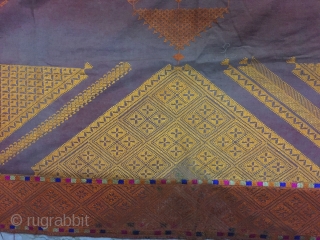Back
The old vintage chope Phulkari
The bride's maternal grandmother (Nani) was starting chope's embroidery as soon as her granddaughter was born. Instead of the common darning stitch, she was using the Holbein stitch which has the specificity of creating the same design on both the sides of the khaddar. This can be interpreted as the grandmother's wish to make her granddaughter equally happy in her life and after her death, on the two sides of her existence.
Chope was made to wrap and dry the bride after the ritual bath she was having before her wedding, for this practical reason chope is bigger than other phulkari.
Its khaddar was invariably dyed in red or orange colour, symbol of passion and happiness. It is worth noticing that chope was never bordered so that this happiness could be unlimited...
Pat was always chosen in golden tones to express desire and wealth.
The Patterns were big triangles symmetrically distributed on the two sides of the chope's longitudinal axis. They were maybe symbolizing male and female principles separated by a distance expressing the fact that the wedding's night had not taken place yet and, thus, that the bride and groom had not had physical intimacy. On another hand these triangles could also represent stylized peacocks.
As well as in other phulkari, some mistakes were voluntarily introduced into the embroidery work in order to protect the bride from the evil eye ("nazar"). Indeed a perfect piece could have attracted others' jealousy.
This principle of keeping others' envy away showing imperfections is found in many oriental traditions. In India, for instance, some black round spots are often drawn on babies faces for this purpose.
Sometimes, chope was also used to cover and hide the bride's dowry, making it invisible to jealous minds and thus keeping the nazar away.
price:
POR
- Home
- Antique Rugs by Region
- Category
- Profiles
- Post Items Free
- Albums
- Benaki Museum of Islamic Art
- Budapest: Ottoman Carpets
- Gulbenkian Museum
- Islamic Carpets. Brooklyn
- Islamic Textiles. Brooklyn
- Konya Museum: Rugs
- MKG, Hamburg
- MMA: Caucasian Carpets
- MMA: Mamluk Carpets
- MMA: Mughal Indian Carpets
- MMA: Ottoman Carpets
- MMA: Safavid Persian Carpets
- MMA: Turkmen Rugs
- McCoy Jones Kilims
- Ottoman textiles. Met
- Philadelphia Museum
- Rugs and Carpets: Berlin
- Seljuqs at the Met
- TIEM, Istanbul: Carpets
- V&A: Classical Carpets
- Vakiflar Carpets: Istanbul
- Baluch Rugs: Indianapolis
- Gallery Exhibitions
- Jaf an Exhibition
- Alberto Levi Gallery
- Andean Textile
- Christie's London: 2016
- Francesca Galloway
- HALI at 40
- ICOC Washington, DC 2018
- Jajims of the Shahsavan
- London Islamic Week April, 2018
- Mongolian Felts
- Navajo Rugs: JB Moore
- Persian Piled Weavings
- SF Tribal & Textile Art Show 2020
- SF Tribal 2019
- Sotheby's: C. Alexander
- Turkish Prayer Rugs
- Turkmen Main Carpets ICOC 2007














